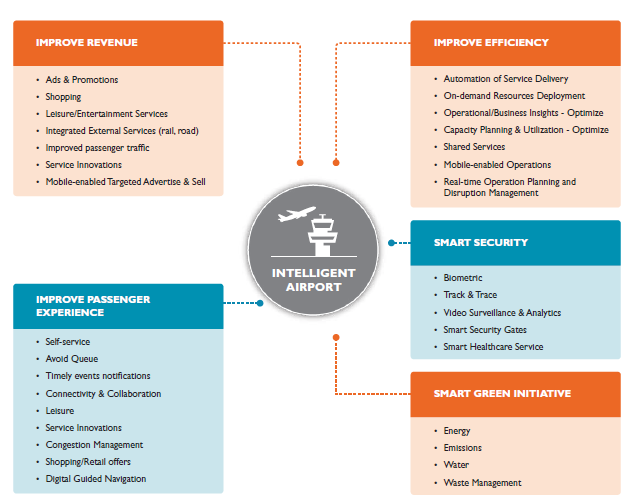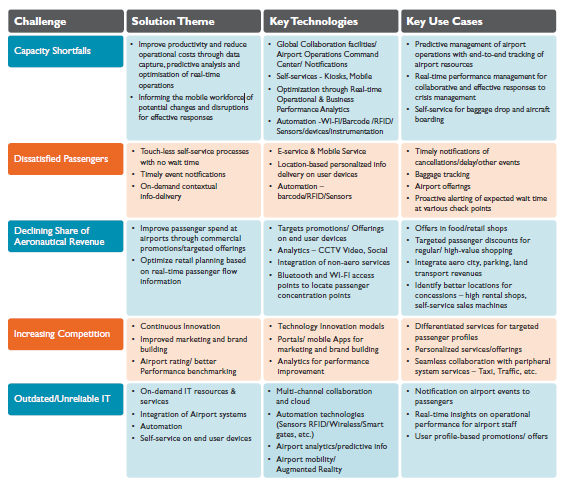Airport as a business is complex, sensitive and different from all the other businesses. As a gateway to the country, state or city, an airport creates the first impression for visitors. Regardless of the size or the type of customers it caters to – International or Domestic - the framework of the airport’s service as well as its complexities and cost elements remain the same. A business that is 24x7 has to be resilient to cater to ever-changing customer demands while being cost-effective.
Introduction
As air traffic grows, airports have to become more adaptive, entrepreneurial and proactive to changing aviation dynamics. With most airports now poised as “multi-nodal” transportation hubs for people, information and trade, the effort is to make systems and processes digitally aware, interconnected, infused with intelligence and simple to access by all stakeholders.
Airports have to deal with challenges such as predicting capacity demand, providing enhanced passenger travel experience, improving operational process efficiency, improving staff productivity, and ensuring safety and security. The need of the hour is to create a unified, integrated, ready-to-use digital platform to assist airports in becoming intelligent and informed.
Many airports today are implementing isolated solutions around intelligent airports. Some of these are mobile-enabled passenger services, introduction of Smart Gates, implementation of Airport Operations Command Centers (AOCC), and airport performance reporting, etc.
While these solutions may improve specific processes and functions, they are not holistic enough. For example, introduction of Smart Gates requires integration with other airport systems and analytics solution to measure the improvements, in which case if there is no holistic integration and analytics solution, it will lead to creating a local solution blocks. Thus, effort should be to move from piecemeal solutions to an enterprise-wide platform-based solution.
Stumbling blocks
To define a holistic solution approach, it is important to look at the key challenges Airport operators face.
Capacity Shortfalls: According to Airport Council International (ACI), with growing demand of air passengers, the total critical infrastructure required to cater to the capacity worldwide would be deficit by 15%, by 2020. This compels Airports to focus on efficiencies or reducing airport costs, as well as better utilization to improve profitability.
Dissatisfied Passengers: Airports today need to deal with growing lack of tolerance for poor agent interactions, baggage fees, lost baggage and flight delays.
Declining Aeronautical Revenues: The worldwide ratio of aircraft-based revenue to passenger-based revenue has remained relatively constant over the last three years, with passenger-based revenue having the greater proportion. Retail is the leading source of income for airports at 29% of the total non-aeronautical income. Property income and rent is tied with parking as the second- largest source of non-aeronautical income at 20% each.
Increased Competition: Airports that are in close proximity to each other, compete to attract airlines by offering them competitive landing fees, dynamic resource allocation, hassle-free co-ordination of multiple services during the aircraft time in the airport, aircraft maintenance facilities and better technologies to improve passenger experience.
Outdated & Unreliable IT Infrastructure: Unreliable IT infrastructure with outdated products & technologies makes the system unavailable and difficult to use. It is difficult to maintain the up-time of IT systems during upgrades, maintenance, and asset refurbishment etc.
Airports need Intelligent Airport platform to address these challenges.
Agile,responsive way forward
The Intelligent Airport solutions platforms are holistic, automated, agile, scalable and responsive. These airports use fault tolerant and scalable Infrastructure and provide real-time data analytics, self-service capabilities on end user devices. This helps in timely access to information, thereby helping in accurate decision-making.
Intelligent Airports help stakeholders in these ways:
B2B, B2G

Figure 1: Intelligent Airports – Our Vision
Intelligent Airports (as seen in Figure 1) extensively use automation and digital technologies. Smart security gates, unmanned immigration systems, real-time CCTV security surveillance, RFID/NFC-based baggage tracking are few such automation technologies used. System-generated alerts/notifications for exceptions/approvals, on-demand self-service capabilities to passengers/staff and executives, user profile-specific targeted promotions and offerings are also a part of the experience these airports have to offer.
A typical airport deploys 30-plus IT systems, is provided by varieties of vendors used in siloes and have limited interoperability. Intelligent airport connects them all to get a better view of integrated airport operations. Airport operations command and control centers help centrally and remotely manage the multi-discipline staff work together.
Over half (53%) of the passengers expect the airline to inform them of any flight-related problems either on a mobile app or via voice call, while 29% of passengers expect notification through social media.
About 45% of passengers expect to have access to self-service options via a mobile or a kiosk and 77% of them are comfortable with staff using wearable technologies, providing information on flight, baggage, boarding process at gate, check-in support and in-flight services. About 90% of the airports worldwide are investing in business intelligence in the next 3 years.
Technologies that Help
The sensor technologies, connectivity, collaboration, mobility and analytics are helping to transform airport operations. Here’s what is helping them wear the “Intelligent” look:
Figure 2 (titled Technologies of Change) shows the solution and key technologies that help overcome the hurdles along the way.

Conclusion
Airports that are turning “Intelligent” will be using multiple intersecting digital and automation technologies that have to converge in addressing the challenges holistically. These technologies help airport operators improve passenger experience, operational efficiencies and compliance, forming the base for future growth. For example, the airports in Las Vegas, Amsterdam and Hong Kong use RFID to track baggage that has resulted in improved baggage sorting and increasing capacity of existing baggage system. Frankfurt Airport and Hong Kong’s Chek Lap Kok International Airport, on the other hand, have achieved improved safety, security and operations efficiency by integrating the real-time management of multiple airport systems and operations into a new AOCC.
However, even though airports globally are trying to wear the “smart” or “Intelligent” look, they are adopting the technologies in a piecemeal manner. The operators need to look at intelligent airport-based approach for sustainability and differentiation. The need is to define a reference architecture for Intelligent Airport Enterprise that would have solution components for analytics, mobility, integration, automation and collaboration. A clear roadmap with incremental implementation of the reference architecture is what is, thus, needed. There is also a need to establish an Intelligent Airport Innovation Council for continuous technology innovation.
Vasuki Upadhya is a Domain Architecture Practice Head, working with Wipro Energy, Natural Resources, Utilities, Engineering & Construction industry segment. He has more than 17 years of experience in various Energy & Utilities areas as well as technology transformations and innovations. He can be reached at vasuki.upadhya@wipro.com.
Deepak Singh Rawat is an Airport domain expert, working with Wipro Energy and Utilities segment focusing on Airports globally. He has 15+ years of experience ranging from Telecom, Manufacturing, Retail with last 5 years focusing on Airport technology, transformations, innovations, operations and can be reached at deepak.rawat1@wipro.com.